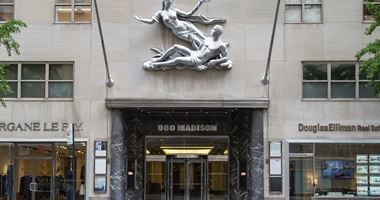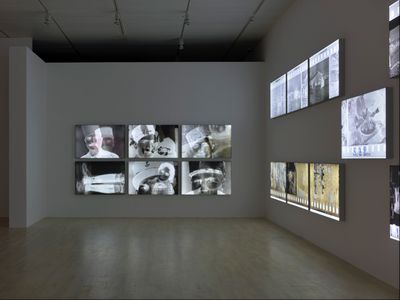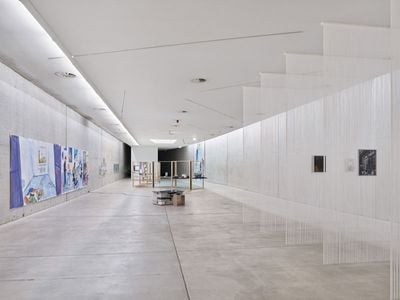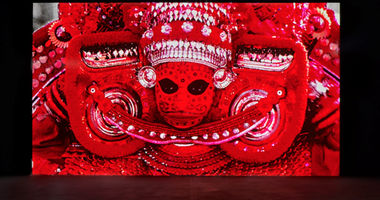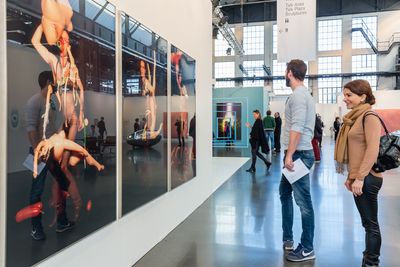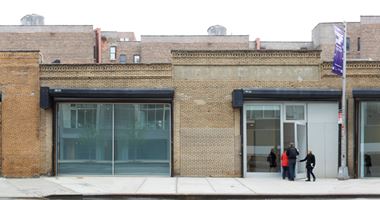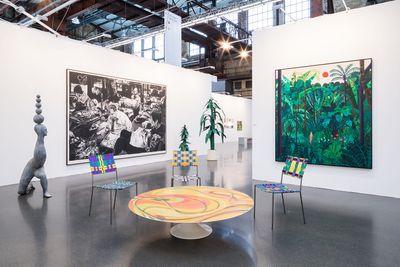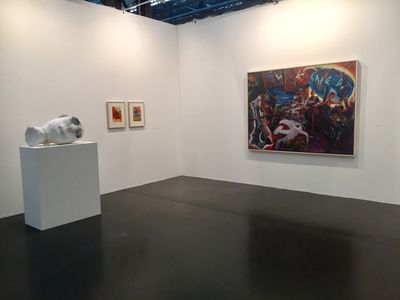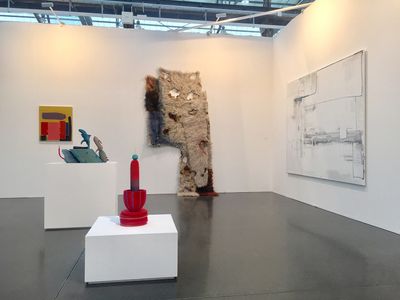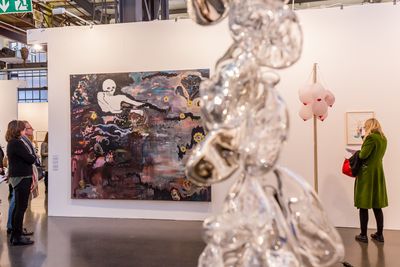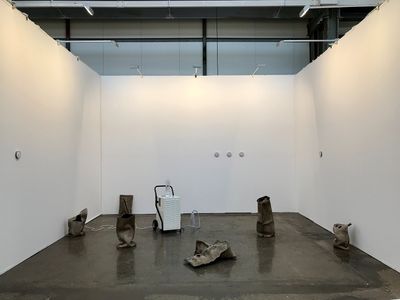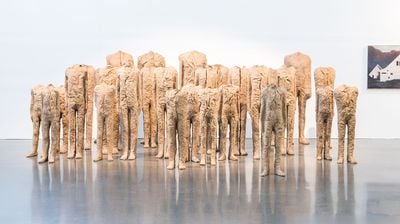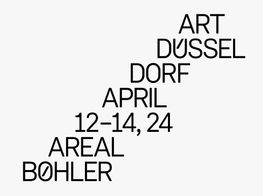A Tale of Two Cities: the first Art Düsseldorf
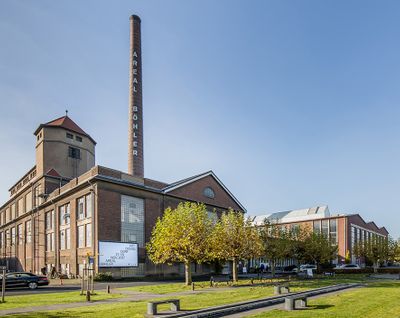
Areal Böhler, Düsseldorf. Courtesy Art Düsseldorf. Photo: Felix Hild.
Düsseldorf, the capital of Germany's most populous federal state and the economic heart of the Rhine-Ruhr region, has developed an identity as a 'trade fair city', with an excellent cultural scene that includes a long list of festivals and cultural institutions.
History came full circle in February 2017, when Art Basel's parent company, MCH Group, announced its acquisition of a 25.1 percent holding in art.fair International GmbH. Co-owned by Andreas Lohaus and Walter Gehlen, art.fair International GmbH ran Art.Fair Köln from 2003 to 2016 before suspending that to launch the first Art Düsseldorf at the 20th-century industrial complex, Areal Böhler from 17 to 19 November 2017. Shortly after MCH's announcement, Koelnmesse, which organises Art Cologne, revealed a takeover of Berlin's abc contemporary and the launch of a new fair, Art Berlin (14–17 September 2017).
Thus new lines were drawn on old grounds, with Art Düsseldorf's establishment representing a convergence of ongoing histories. Established in 1967, Art Cologne is known as the first modern and contemporary art fair, which spawned similar events. Prospect 68: International Preview of the Art in the Galleries of the Avant-garde was organised at Kunsthalle Düsseldorf in September 1968 by gallerist Konrad Fischer, offering an international alternative to Cologne's German-centric floor—an internationalism that formed Art Basel's identity when it started in 1970.
At the time, Amsterdam, Antwerp, Cologne and Düsseldorf represented a regional art axis—something Studio for Propositional Cinema paid tribute to in its final exhibition at its Ackerstrasse space, formerly Daniel Spoerri's studio: drawings and watercolours by Bernd Lohaus, co-founder of Antwerp's historic Wide White Space (Blumen, 21 October–19 November 2017).
In reaction to this developing competition, Art Cologne rebranded in 1974 as Internationaler Kunstmarkt, alternating its location between Cologne and Düsseldorf until 1983, when Cologne became the fair's permanent venue. In the decades that followed, Art Basel became a global behemoth while Art Cologne remained distinctly regional, with a recent revival credited to the efforts of current director Daniel Hug (Gagosian and White Cube participated for the first time in 2017).
Meanwhile, Düsseldorf, the capital of Germany's most populous federal state and the economic heart of the Rhine-Ruhr region, developed an identity as a 'trade fair city', complete with a Media Harbour boasting Frank Gehry statement buildings, and an excellent cultural scene with a list of festivals ranging from the Duesseldorf Photo Weekend to the New Fall music festival.
Some 26 museums are based here, including the Kunstsammlung Nordrhein-Westfalen, whose collection was founded on a donation of 88 Paul Klee works, and where Akram Zaatari's exhibition Against Photography. An Annotated History of the Arab Image Foundation is currently on view (18 November 2017–25 February 2018), with Carmen Herrera and Maria Hassabi exhibitions opening in December 2017.
At the centre of it all is the historic Düsseldorf Kunstakademie, where the city's 19th-century school of painting and 20th-century school of photography were founded; where Nam June Paik and Joseph Beuys taught; and next to which the famous Creamcheese Club hosted some of Kraftwerk's first gigs. (On this history, Electri_City, The Düsseldorf School of Electronic Music, by Die Krupps bass player Rudi Esch, has recently been translated into English with Omnibus Press.)
Celebrating their 50th anniversary at Grabbeplatz is an expansive exhibition at Kunsthalle Düsseldorf, Academy [Working Title], which includes professors and students of the Düsseldorf and Münster Kunstakademies and the Kunsthochschule für Medien Köln (KHM), with another show, Akademie, conceived in collaboration at KIT–Kunst im Tunnel (both 21 October 2017–7 February 2018).
For a time, there seemed to be a neat division between two of Germany's most important (and historical) cities for art, which are some 50 kilometres apart. Institutions and galleries aside, Cologne had the art fair and Düsseldorf had the artists and some major collectors, with a number of private foundations based here. These include Sammlung Philara, KAI 10 | Arthena Foundation, and Julia Stoschek's famed video and time-based collection, currently celebrating ten years with a game-changing exhibition curated by Ed Atkins. The arrival of Düsseldorf's MCH-backed fair looks set to disrupt this balance, while also feeding into developments that have been unfolding in the city's art scene since the early 2000s, which academic Timotheus Vermeulen called a 'little renaissance'.
One key factor behind Cologne's appeal is the access it offers to the Rhineland's coveted collector base ('well informed, intellectual, and as solid as the German Mittlestand,' to quote Hili Perlson), which Art Düsseldorf is now banking on. According to Walter Gehlen, some 50 percent of Europe's art collectors apparently reside within a two-hour radius of Düsseldorf, which sits within the so-called Blue Banana (an economic zone that stretches from Manchester to Milan) and is in close proximity to the Benelux countries, a politico-economic union made up of Belgium, the Netherlands, and Luxembourg.
Art Düsseldorf's inaugural edition was premised on a regional identity that focuses on this geography, with 50 percent of the floor reserved for German and Rhineland galleries, 10 percent from Benelux, and 40 percent offered to international spaces, including Edouard Malingue Gallery and 313 Art Project; numbers that distinctly overlap with Art Cologne's. (Though each fair's size differs substantially, with Düsseldorf showing some 80 galleries, and Cologne giving space to roughly 200.)
These overlaps were palpable on Art Düsseldorf's floor, notably with David Zwirner, the son of Art Cologne co-founder Rudolf Zwirner, given pride of place at the fair's entrance near Hans Mayer, a founding gallery of Kunstmarkt Köln, who was awarded the Art Cologne Prize in 2015.
Mayer presented a booth dedicated to the 2017 'Bodysounds' series by Cologne-based artist Jürgen Klauke, whose raucous 1977 'Dr Müller's Sex-Shop oder so stell ich mir die Liebe for' series was on view at Galerie Thomas Zander's booth next door, among works by artists including Peter Alexander, Candida Höfer and Lothar Baumgarten.
In keeping with the context, Zwirner paid tribute to the Rhineland's art history by presenting some of the Kunstakademie's former students and teachers, including Isa Genzken, Thomas Ruff and Christopher Williams. Likewise, works by Jose Beuys were spotted at Galerie Heinz Holtmann and Galerie Bastian, and Schönewald Fine Arts showed photographs by Bernd and Hilla Becher, founders of the Düsseldorf School of Photography.
Also spotted at Schönewald were drawings by Kunstakademie student and professor Konrad Klapheck, whose 1963 oil on canvas painting of what appears to be an electric rod wrapped in orange and green wire, Jugend, was placed in a genius pairing with Elias Hansen's electric bulb assemblages at OV Project's booth. Elsewhere, König Galerie—whose founder called Art Düsseldorf 'nonsense' in April 2017—showed a large installation by Kunstakademie alumnus Andreas Schmitten, Wald (2017), alongside Annette Kelm's Düsseldorf-influenced photographs and Jose Dávila's neo-minimalist sculptures.
At Carolina Nitsch, former Academy student Thomas Schütte showed Architecture Models, 1980–2006 (2006): 27 etchings detailing hypothetical designs, including a 'Hotel for the birds' and a 'Tower for Talkers', alongside the wooden Model for a Museum (1982). Düsseldorf-based Schütte has a sculpture foundation located within the Museum Insel Hombroich complex in nearby Neuss (founded by collector Karl-Heinrich Müller), which also hosts the Tadao Ando-designed Langen Foundation building on its premises: a former NATO base where paintings by Kunstakademie alumnus Norbert Tadeusz are on view in one of eleven pavilions designed by the sculptor Erwin Heerich, to magnificent effect.
At the fair, Galerie Utermann showed works by Tadeusz, as well as Norbert Kricke, who is likewise included in Insel Hombroich's impressive collection, which boasts works by Picabia, Schwitters and others—plus architect Raimund Abraham's last realised project. (On the fair floor, Heba Y. Amin's large iron sculptures at Zilberman Gallery related beautifully to Kricke's wire sculptures.)
Beyond the Kunstakademie, galleries showed artists who were born or are based in Düsseldorf. Tim Van Laere Gallery's playful booth included pieces by Kati Heck—such as a large 2017 sculpture made out of textile, metal, polyester filling and polyurethane of what appear to be footballer's legs (presumably named after Michaelangelo's David, and/or Beckham)—alongside a wonderful group of paintings and sculptures by Ben Sledsens, Anton Henning, Anke Weyer, Henk Visch, Franz West, Rinus Van de Velde and Jonathan Meese, whose recognisable canvases were also spotted at Galerie Krinzinger, Sies + Höke and Galerie Daniel Templon.
In the case of Montrasio Arte, a fantastic selection of ceramics by Lucio Fontana were placed in conversation with those by Fausto Melotti, Gianni Moretti and Piero Manzoni, among others—Fontana having inspired the 1964 documenta 3 installation Light Room (Homage to Fontana) by ZERO artists Gunther Uecker, Otto Piene and Heinz Mack (represented in a few spaces at the fair, including Galerie Löhrl, alongside great paintings by Roman Kochanski and photographs by Anett Stuth).
Light Room is on permanent display at Düsseldorf's Museum Kunstpalast, located in the historic Ehrenhof complex, whose collection includes a pair of large Rubens from the days of Elector Palatine Johann Wilhelm II (or Jan Wellem), who—along with his wife Anna Maria Luisa, commonly known as 'the last Medici'—encouraged a culture of artistic patronage in the city from the 17th century onwards. (Wilhelm's collection formed the basis of the Kunstpalast's holdings, along with Kunstakademie founder Lambert Krahe's marvellous inventory of prints and drawings.)
So far, all galleries mentioned have taken part in Art Cologne (apart from Zilberman)—and there are more to list. New York's CANADA shared a booth with Düsseldorf-based Linn Lühn, with the former gallery presenting a wonderful group of large, figurative acrylic on canvas paintings by Katherine Bradford, whose colour scheme of purples, fuchsias, oranges and browns (with elements of canary yellow, navy blue and lime green) corresponded to Sarah Braman's acrylic and fabric dye on plywood geometric painting In Spite of Ourselves (2017), which acted as both divider and connector between the two gallery spaces.
Beyond this, Linn Lühn showed paintings by Christoph Schellberg, ceramic lamps by Carmen D'Apollonio and Phuc (2017)—a three-dimensional cardboard cubist construction—by Florian Baudrexel.
On the booth's outer wall were small oil on canvas paintings of foliage, martini glasses and American Spirit cigarette packets by Dike Blair, also on view at New York's Karma, whose booth also showed works by Walter Price, Matthew Wong and Daniel Turner. (The New York-Düsseldorf connection was strong at this fair, pointing to—and updating—the relationship between each scene, with Brooklyn gallery Century Pictures offering an amazing pairing of 1980s paintings by late Kunstakademie student and professor Jörg Immendorff—also spotted at Michael Werner Gallery—with large 2013 plaster busts of various 'frat guys' byNicole Eisenmann.)
In another shared booth, Düsseldorf gallery Van Horn presented a series of works—including paintings by Joanne Greenbaum and sculptures by Düsseldorf-based artist Diango Hernández—alongside Cologne-based gallery Markus Lüttgen, whose presentation included a large acid-dyed wool wall piece, Appalachia (2016), by Anna Betbeze, and Matthew Ronay's brightly flocked sculptures, including The Great Interval (2017)—a semi-abstract rendering of an oceanscape, complete with forms suggestive of a seahorse and shark.
Cologne connections aside, a few surrealist curatorials are worth mentioning, including Frankfurt-based Die Galerie's solo presentation of Roberto Matta, and Rodolphe Janssen's eccentric assemblage that featured, among other works, Louisa Gagliardi's purple-scale Nicolas Party-esque portraits of women smoking, Thomas Lerooy's bronze cherubs with gilded skulls for heads, paintings by Sanam Khatibi and a series of canvases and vases by Gert & Uwe Tobias.
carlier | gebauer's weird and wonderful arrangement included Laure Prouvost's Cooling system 1 (b) (for global warming) (2017)—a coat stand topped with hanging pink, breast-like glass balloons shown alongside a watercolour of two people taking cover under said stand—and paintings by Laure Prouvost, Hélène Delprat, and one North-Korean embroidered chandelier by Kyungah Ham, What you see is the unseen / Chandeliers for Five Cities BR 04–94 (2016).
Close by, Brussels' Albert Baronian's grouping included Aline Bouvy's white Jesmonite wall dogs and paintings by Helmut Stallaerts—including Transparency (2017), an oil and blood on canvas depicting lines of people performing push-ups—and Thomas Zipp, who was also spotted at Galerie Krinzinger's booth.
At Green on Red Gallery, perfectly executed paintings by Damien Flood and Caroline McCarthy stood out; Yves Saint Laurent drawings shone at Galerie Neu; and Galerie Gregor Staiger's booth framed Sonia Kacem's large floor sculpture made from awning fabric solidified by epoxy, Monstering II (2015), with small oil paintings by Marvin Gaye Chetwynd.
Injecting some timely, tongue-in-cheek politics into the fair was Galerie Peter Kilchmann, whose outer wall was reserved for a powder-coated aluminium frame by Los Carpinteros depicting the face of Angela Merkel illuminated by LED lights, It's Not Che, It's Angela Merkel (2014), beyond which a drawing by the duo, Babel Gris (2017) was hung by a chicken-wire sculpted Garbage Child 4 (1974) by Vlassis Caniaris.
With one of the largest booths in the fair, Marlborough Contemporary's well-curated space featured nude portraits by Alex Katz and Werner Büttner, sculptures by Tony Matelli, and a 2015 inkjet print by Julius von Bismarck of a desert rockscape, Landscape Painting (Desert), among other works. Bismarck's desert images were also shown at Sies + Höke, alongside excellent pieces by Marcel Dzama, Talia Chetrit and Claudia Wieser.
Bismarck was also represented, alongside Fabian Knecht, at alexander levy, showing in the fair's Post-Lehman sector, which spotlighted 13 galleries founded after the 2008 economic crash. Some great booths here included ChertLüdde, showing works by Rodrigo Hernández, Kasia Fudakowski and Petrit Halilaj; Sperling, presenting Thomas Geiger's set of eight concrete pavement sculptures, Private Monuments (A stage to empty your pockets) (2017) and Anna Vogel's rippling indian ink on pigment paper works; and Lisbon's Galeria Francisco Fino, whose solo booth by artist Adrien Missika won the Post-Lehman Presentation Award.
Expanding on the concept of connectivity in the Post-Lehman sector was Düsseldorf's Galerie Max Mayer, which collaborated with Tokyo gallery Misako & Rosen to show a large Ei Arakawa LED light painting with small paintings and collages by Richard Aldrich. Misako & Rosen participated in the recently launched gallery-share initiative Okey Dokey, which saw nine Cologne and Düsseldorf galleries, including Mayer's, hosting spaces from abroad.
Beyond shared booths, divisions felt less defined among individual spaces. Take Piero Atchugarry Gallery's grouping of marble sculptures by Pablo Atchugarry, intricate newspaper interventions by Yuken Teruya and delicate works on paper Marco Maggi, whose Uruguay Pavilion, Global Myopia, at the 2015 Venice Biennale was one of the best in show. To the side of the booth was a wall of framed works from Günther Uecker's portfolio Graphein (2002), which visually connected to Atchugarry's arrangement, though it was joined to Galerie Dr Dorothea van der Koelen's presentation on the wall's other side.
At Galerie Dr Dorothea van der Koelen, a curatorial worked with the aesthetics of Areal Böhler's industrial interior, with geometric Plexiglas windows by former Kunstakademie student Daniel Buren lined up against a wall to mirror the square window panes above, and gold leaf and Japanese paper geometric reliefs by Lore Bert. Berlin Gallery Dittrich & Schlechtriem also engaged with the fair's venue, hanging prints of octopi by Andreas Greiner (Petra and Alfredo, both 2017) on industrial columns, which were admittedly overshadowed by Greiner's giant steel, polylactic acid and 3D print of a bird skeleton, Monument for the 308 (2017).
In other cases, connections between galleries were made through specific artists, with Leiko Ikemura's distinctive paintings and sculptures seen at Priska Pasquer and Galerie Michael Haas, where Pia Stadtbämer's jesmonite hands hanging from polyester ropes from the series 'They Thought It's Human' (2015–2017) stood out. Similarly, Petra Rinck Galerie, positioned in the Post-Lehman sector, showed an excellent two-person presentation of textile works by Emma Talbot alongside laser toner on paper prints of neatly rendered orbs by Marsha Cottrell, which were also shown at Van Doren Waxter next to Hedda Sterne's stunning ink on paper portraits from c. 1965–68.
In the case of Fabrizio Plessi, sculptures were on view at Galerie Dr Dorothea van der Koelen, Mario Mauroner Contemporary Art and Beck & Eggeling, where the LED-flat panel video installation Energy (2017), which reportedly sold for 480,000 Euros, was shown alongside such works as Magdalena Abakanowicz's impressive installation of headless burlap and resin bodies, 30 Standing Figures (1990–2000).
Yet, despite these associations, the relationship between the two art fairs now seemingly pitted against each other remains to be seen. Having successfully established a strong regional character from the get go, how Art Düsseldorf will affect Art Cologne is currently a question without an answer, though most agree that the latter fair could well benefit from the challenge this competition brings.
Beyond that, it will be interesting to observe in the coming years how both fairs deal with the roughly 40 percent of space held for international galleries, not to mention how Art Düsseldorf will benefit from its association with MCH Group and its global network of collectors and exhibitors, which could diversify the field of participants and attendees. Suffice it to say, with MCH's option to acquire a majority stake as time goes by, and Art Berlin launching to lacklustre reviews (Berlin is a city with no collectors, it is often said), the stakes are high—particularly if Art Düsseldorf expands in size. —[O]

